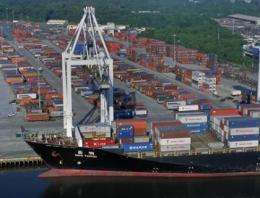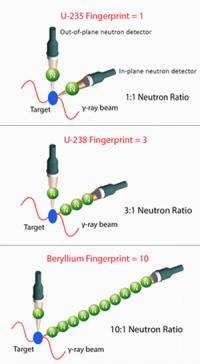Physics for safer ports: New technology uses nuclear 'fingerprints' to scan cargo ships

While 700 million travelers undergo TSA's intrusive scans and pat-downs each year, 11 million cargo containers enter American ports with little screening at all. And the volume of those containers, roughly equivalent to 590 Empire State Buildings of cargo, could contain something even worse than box knives or exploding shoes, namely nuclear weapons.
Two teams of North Carolina physicists are mapping the intricacies of the atomic nucleus, which could provide better security at the ports. The scientists have identified new "fingerprints" of nuclear materials, such as uranium and plutonium. The fingerprints would be used in new cargo scanners to accurately and efficiently identify suspicious materials. The physics might also be used to improve analysis of spent nuclear fuel rods, which are a potential source of bomb-making materials.
The problem starts at ports, where terrorists may try to smuggle an entire dirty bomb or even smaller amounts of plutonium or uranium by hiding it within the mountains of cargo that pass into the country each day. Cargo scanners using the new nuclear fingerprints would be sensitive enough to spot an entire bomb or the smaller parts to build one, according to Mohammad Ahmed, a nuclear physicist at Duke University.
Ahmed and his colleagues are developing the fingerprints for the next-generation detectors with HIGS, the High Intensity Gamma-Ray Source. It is the world's most intense and tunable source of polarized gamma rays and is located on Duke's campus as part of the Triangle Universities Nuclear Laboratory. HIGS produces gamma rays that are guided to collide with target materials, causing a variety of nuclear reactions.
In the reaction Ahmed and his Duke colleagues study, the collision creates a spray of particles, which fly into a group of detectors. The detectors count the number of neutrons knocked from the atomic nuclei of the target material in either a parallel or perpendicular direction, compared to the polarization plane of the gamma-ray beam. Dividing the number of neutrons emitted parallel to the plane by the number emitted perpendicular is distinct to each material, giving it a unique fingerprint.
Ahmed said these fingerprints could eventually be used to distinguish special nuclear materials, like weapons-grade uranium, from naturally occurring uranium or ordinary objects such as clothing or granite countertops, distinctions that current port scanners cannot make.
In a separate but related project, nuclear physicists from three North Carolina universities are slamming the HIGS beam into atomic nuclei and observing the energy pattern and distribution of the gamma rays that fluoresce back out of the collision. Each material has a distinct fluorescence pattern based on its nuclear structure, according to physicist Calvin Howell, who leads the Duke group.

Howell and his collaborators are studying the fluorescence patterns of potentially dangerous nuclear materials and non-nuclear contraband such as explosives and drugs. They are also identifying the patterns of steel and lead because terrorists can use the metals to conceal and ship weapon-making materials.
The two anti-terrorism projects were developed with the support of the Department of Homeland Security's Domestic Nuclear Detection Office, or DNDO. The agency awarded Ahmed and his colleagues a $2 million grant, while Howell and his collaborators received grants totaling $2 million. DNDO is funding both projects in response to the SAFE (Security and Accountability For Every) Port Act of 2006, which requires security agents to scan for nuclear materials in all of the containers entering the United States through the nation's 22 busiest ports.
Five years after Congress and the president approved the legislation, the equipment to satisfy this mandate still doesn't exist. Meanwhile, the United States transfers about 20 percent of the world's freight across its borders and has more than 300 maritime ports for sea containers and an additional 300 access points, such as border crossings, where dangerous materials might enter the country.
The Duke scientists say their use of polarized gamma-ray beams could one day help satisfy the SAFE policy, and they are building the fingerprint library to make it happen.
The HIGS data show, for example, that a precisely tuned gamma beam at 6 MeV causes weapons-grade uranium, U-235, to emit one neutron parallel to the polarization plane for each neutron emitted perpendicular to the plane, giving the material a neutron fingerprint of one.
Naturally occurring uranium, U-238, emits three parallel neutrons for every one emitted perpendicular to the polarization plane of the beam, giving it a neutron fingerprint of three.
Beryllium, which can also be a neutron source in nuclear weapons, has a neutron fingerprint of 10. The team is now measuring the neutron fingerprints of plutonium and other fissile materials, Ahmed said.
Howell and his collaborators, meanwhile, work at lower energies on HIGS, about 3 MeV. (Surgeons, for comparison, use a "Gamma Knife" at roughly 1 MeV to treat brain tumors.) Their team has already identified the fluorescence patterns of several special nuclear materials and lead.
Both teams will report their results at a meeting with DNDO officials on Thursday, April 28 in Washington D.C. and will store their results in a nuclear identification database.
Ahmed and Howell said that engineers at one private security company and scientists at U.S. national laboratories have already begun using the database to design new port security scanners.
The new detectors will search cargo for the fingerprints using an electron accelerator, possibly coupled to lasers that produce a finely tuned gamma-ray beam, said Craig Wuest of the Global Security Principal Directorate at Lawrence Livermore National Laboratory (LLNL).
The design sounds complex, but in some ways it resembles medical scanning equipment and appears promising to pursue, he said.
Howell's "nuclear resonance fluorescence" approach is interesting because it uses a beam with lower-energy gamma rays and reduces the potential irradiation and contamination of cargo while providing "sufficient detection sensitivity," Wuest, who was not involved in the research, added.
One of Wuest's colleagues at LLNL, nuclear physicist Dennis McNabb,is more intrigued with Ahmed's and Weller's technique. Scientists are only just beginning to measure the fingerprints and background signatures from this neutron-scattering process, and because "the research is in progress, how to best use the data is still an open question," McNabb said.
He also explained that cargo scanners using the data from both teams could be ready for use at ports in about 10 years.
Still, some scientists question whether the emerging science and technology can mature fast enough to meet the real-world threats of terrorists and dirty bombs. For instance, Thomas Cochran, a physicist and senior scientist at the Natural Resources Defense Council, voiced "serious doubts" and said the government should focus instead on eliminating inventories of highly enriched uranium, improving port security, boosting intelligence efforts and training first responders.
Other experts disagree and are urging the government to accelerate research on new science and technologies that could significantly reduce the threat of nuclear weapons smuggling, which seems likely to persist into the next decade. McNabb, a proponent, said, "it takes time to develop new technologies" and suggests that the research may accelerate development in other areas of nuclear security.
The new information from HIGS could improve analysis of spent nuclear fuel rods, which are an environmental issue as well as a potential source of bomb materials, according to Duke physicist Anton Tonchev.
He works on the nuclear resonance fluorescence project with Howell and said the technique provides a nondestructive way to measure the quantities of plutonium and other nuclear materials that remain after the rods are removed from a nuclear reactor.
Currently, the spent fuel rods must be opened and tested to assess what materials remain in them. The process is expensive, but critical for the International Atomic Energy Agency to accurately calculate the amount of leftover fissile and nuclear materials. McNabb and Tonchev said that a new technique to distinguish the leftover U-235, U-238 and plutonium in the spent rods without opening them could substantially lower the costs to manage and account for nuclear waste to prevent nuclear proliferation by terrorists.
Regardless of how fast engineers turn the fingerprint data and new approaches into workable scanning and nuclear fuel devices, the Duke scientists said there is immediate value in compiling a robust database of both the neutron and nuclear resonance fluorescence fingerprints. Government officials at the DNDO concur and cite HIGS as the only facility with the ability to produce such a database, according to Ahmed.
Because of the demand, the physicists have recruited graduate and undergraduate students from Duke, University of North Carolina, North Carolina Agricultural and Technical State University, North Carolina Central University, James Madison University and George Washington University to help with the effort. They especially encourage students from historically black colleges and universities to participate, hoping the effort will help broaden the diversity of nuclear physicists working to identify new ways to curb the threat of future terror attacks.
Provided by Duke University
















